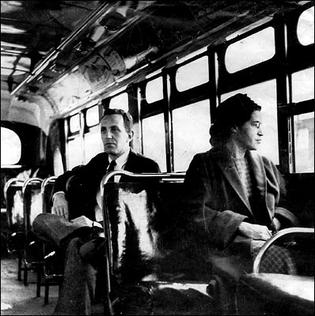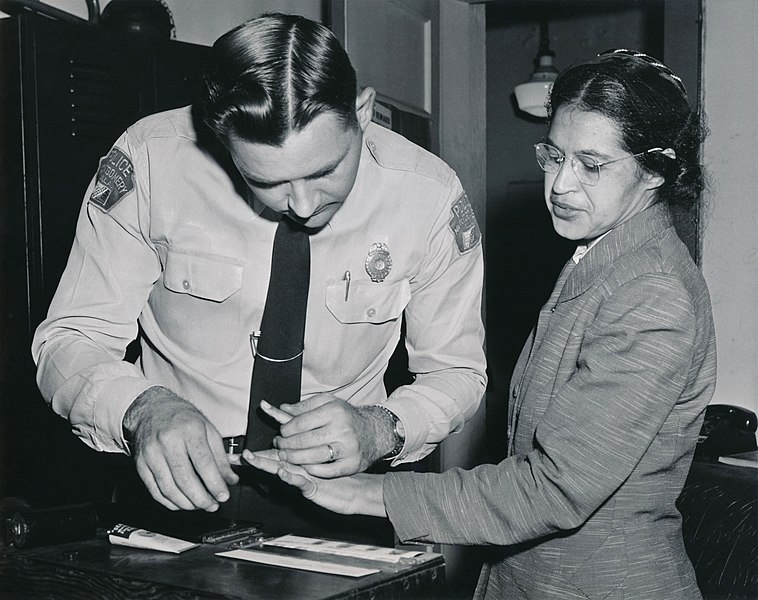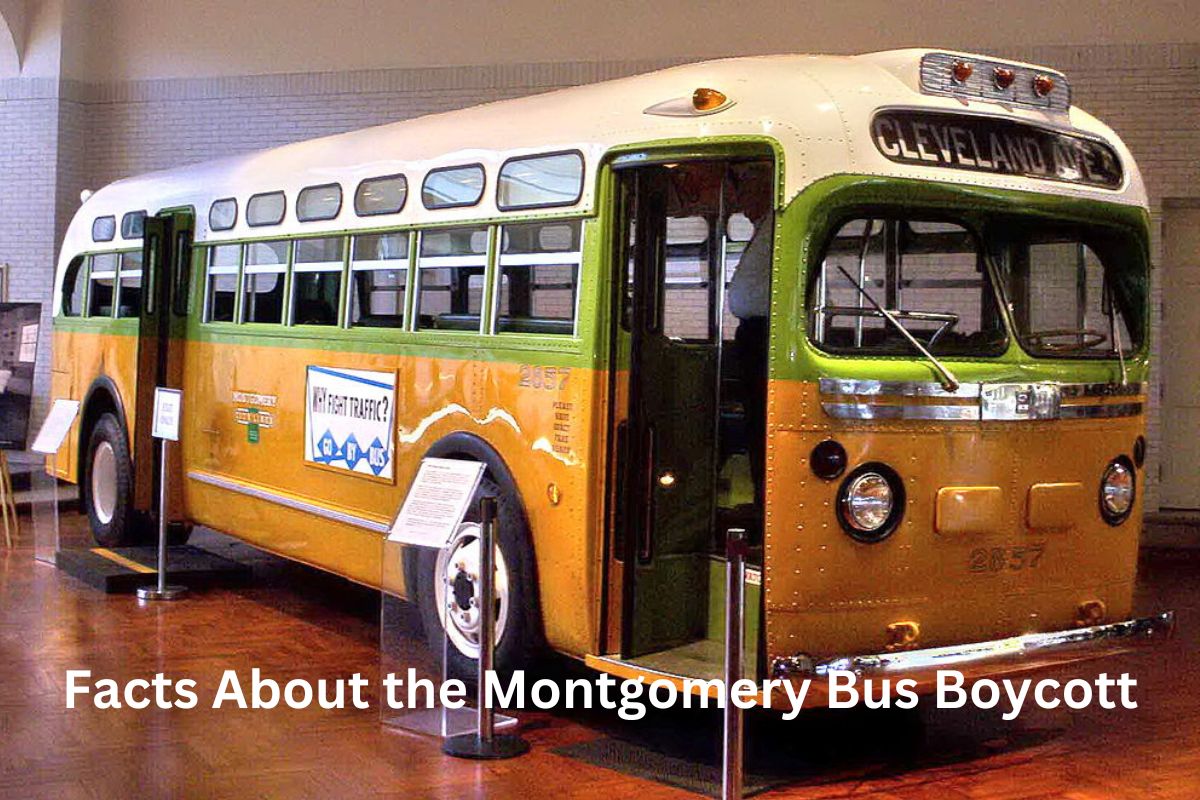The Montgomery Bus Boycott was a pivotal event in the American civil rights movement that took place in Montgomery, Alabama, from December 1955 to December 1956. It was sparked by the arrest of Rosa Parks, an African American woman who refused to give up her bus seat to a white passenger.
Organized by the Montgomery Improvement Association (MIA) and led by Dr. Martin Luther King Jr., the boycott aimed to challenge racial segregation on the city’s buses through nonviolent resistance.
The boycott had a significant economic impact, inspiring a carpool system to provide alternative transportation for African Americans. It culminated in a landmark Supreme Court ruling that declared bus segregation unconstitutional.
The boycott’s success catapulted Dr. King to national prominence and inspired future civil rights protests across the United States, highlighting the power of collective action and nonviolent resistance in the fight for equality.
Montgomery Bus Boycott Facts
1. The Montgomery Bus Boycott was a significant civil rights protest that took place in Montgomery, Alabama
The Montgomery Bus Boycott was a significant civil rights protest that took place in Montgomery, Alabama, from December 5, 1955, to December 20, 1956.
Also Read: Facts About Brown vs Board of Education
It was a pivotal event in the American civil rights movement and served as a catalyst for change. The boycott lasted for over a year, making it one of the longest-lasting and impactful protests in history.
2. The boycott was sparked by the arrest of Rosa Parks
The boycott was sparked by the arrest of Rosa Parks, an African American woman who refused to give up her bus seat to a white passenger on December 1, 1955.
Also Read: Little Rock Nine Facts
Parks’ act of defiance was not the first of its kind, but it gained widespread attention and became a symbol of resistance to racial segregation. Her arrest galvanized the African American community in Montgomery and sparked a determined response.

3. The Montgomery Bus Boycott was organized by the Montgomery Improvement Association (MIA), led by Dr. Martin Luther King Jr
The Montgomery Bus Boycott was organized by the Montgomery Improvement Association (MIA), led by Dr. Martin Luther King Jr.
Also Read: Montgomery Bus Boycott Timeline
The MIA was formed to coordinate the protest and advocate for equal rights. After Rosa Parks‘ arrest, local African American leaders, including E.D. Nixon and Jo Ann Robinson, met to discuss a collective response.
They formed the MIA and elected Dr. Martin Luther King Jr., a young and emerging pastor in Montgomery, as their leader. Under Dr. King’s guidance, the MIA developed strategies to sustain the boycott and create a platform for dialogue and change.
Dr. King’s eloquence and commitment to nonviolent resistance became central to the success and philosophy of the boycott.
The MIA organized mass meetings, distributed leaflets, and used local churches to mobilize support for the boycott. It also coordinated efforts to establish alternative transportation methods, such as carpools, to ensure that African Americans could continue their daily activities without relying on the bus system.
The MIA’s disciplined approach and Dr. King’s inspirational leadership were instrumental in maintaining the momentum of the boycott and securing its ultimate success.
4. The boycott was a nonviolent resistance campaign aimed at ending racial segregation on the city’s buses
The boycott was a nonviolent resistance campaign aimed at ending racial segregation on the city’s buses. At the time, Montgomery’s bus system enforced a policy of racial segregation, which required African Americans to sit at the back of the bus and relinquish their seats to white passengers if the white section became full.
This unjust and discriminatory practice sparked outrage within the African American community. The boycott sought to challenge and dismantle this system of segregation by refusing to use the buses until equal rights were granted.
5. During the boycott, African Americans organized a carpool system called the Montgomery Bus Boycott
During the boycott, African Americans organized a carpool system called the Montgomery Bus Boycott, where they shared rides to work and other destinations to avoid using the buses.
The carpool system was a remarkable display of solidarity and community cooperation. African Americans coordinated their efforts, arranging carpools through church networks, community organizations, and word of mouth.
This grassroots mobilization allowed people to continue their daily routines while effectively withdrawing their support from the segregated bus system. The carpool system demonstrated the resilience and determination of the African American community in the face of adversity.

6. The boycott had a significant economic impact on the bus system in Montgomery
The boycott had a significant economic impact on the bus system in Montgomery. African Americans constituted a majority of the bus ridership, and their refusal to use the buses led to a sharp decline in revenue for the Montgomery City Lines, the company that operated the bus system.
As the boycott persisted, the bus company faced mounting financial losses, as the majority of their customers were effectively boycotting their services.
The economic impact sent a strong message to the city’s officials and business leaders that racial segregation was not only morally wrong but also economically unsustainable.
The financial pressure further contributed to the eventual success of the boycott and added urgency to the push for change.
7. The legal battle against bus segregation led to a landmark Supreme Court ruling
The legal battle against bus segregation led to a landmark Supreme Court ruling. In December 1956, the United States Supreme Court declared bus segregation in Montgomery unconstitutional in the case of Browder v. Gayle.
The ruling affirmed that racial segregation on public transportation violated the Fourteenth Amendment’s guarantee of equal protection under the law.
The Supreme Court’s decision marked a significant victory for the civil rights movement and provided a legal precedent that extended beyond Montgomery, impacting segregation practices in other cities and transportation systems.
8. The success of the Montgomery Bus Boycott brought national attention to the civil rights movement
The success of the Montgomery Bus Boycott brought national attention to the civil rights movement and catapulted Dr. Martin Luther King Jr. to national prominence as a leader and advocate for equal rights.
Dr. King’s role in organizing and leading the boycott, along with his powerful speeches and commitment to nonviolent resistance, garnered widespread recognition.
The boycott demonstrated the power of collective action and nonviolent protest in effecting social change. Dr. King’s leadership during the boycott laid the foundation for his future endeavors as one of the most prominent figures in the civil rights movement.
9. The Montgomery Bus Boycott inspired and paved the way for other civil rights protests and demonstrations
The Montgomery Bus Boycott inspired and paved the way for other civil rights protests and demonstrations across the United States. The successful outcome of the boycott energized the civil rights movement and emboldened activists to challenge segregation and discrimination in various forms.
The strategies and principles employed during the boycott, such as nonviolent resistance and community mobilization, became influential models for subsequent protests and movements. The boycott’s impact resonated far beyond Montgomery, shaping the trajectory of the broader struggle for civil rights in America.
10. The Montgomery Bus Boycott marked an important milestone in the civil rights movement
The Montgomery Bus Boycott marked an important milestone in the civil rights movement, demonstrating the power of collective action and nonviolent resistance in the fight against racial segregation and discrimination.
The successful boycott shattered the notion that African Americans had to accept subjugation and unequal treatment. It showed that when people come together to challenge injustice with determination, resilience, and peaceful means, they can effect lasting change.
The Montgomery Bus Boycott remains a symbol of courage, unity, and the indomitable spirit of those who fought for justice and equality during a pivotal era in American history.
